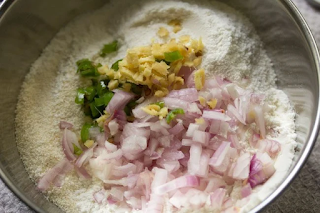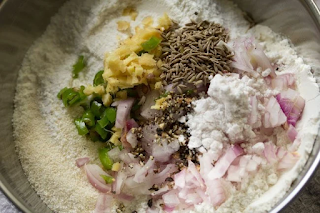How is Instant Rava Dosa made?
A thin batter is
made of sooji, rice flour, maida and water or buttermilk. The batter is spiced
with onions, green chilies and some more herbs & spices.
The batter is then
poured on a hot tawa (griddle) to get netted effect on the dosa. The dosa is
cooked till golden crisp and then served hot.
To make perfect
crisp instant rava dosa which has a netted texture, the batter has to be thin.
So always remember that the batter should be thin and easy to flow.
Also allow some soaking time for rava or
suji, so that they soften. I usually mix everything and set the batter aside
for 20 to 30 minutes.
How to make Rava Dosa
Make Batter
1. Take ½ cup unroasted fine rava, ½ cup rice flour and ¼ cup all-purpose flour in a bowl.
2. Then add ⅓ cup chopped onions, 1 or 2 green chillies (about ½ to 1 teaspoon finely chopped), and ½ teaspoon finely chopped ginger.
3. Also add ½ teaspoon crushed black pepper, ½ teaspoon cumin
seeds, 8 to 10 curry leaves (about 1 tablespoon chopped) and salt as required.
At this point you can also include 1 to 2 tablespoons of chopped coriander leaves, 2 tablespoons of fresh grated coconut or 1 to 2 tablespoons of chopped cashews.
4. Add 2.25 to 2.5 cups water. Depending on the quality of rava or
suji and rice flour, you can add less or more water – from 2 to 2.5 cups water.
I added 2.25 cups of water. You can also use buttermilk instead of water.
5. Whisk till smooth without any lumps. The
batter has to be flowing and thin. If the batter looks thick or has a medium
consistency, then add more water. If the batter looks very thin and runny, then
add some rice flour.
6. Cover and let the batter rest for 20 to 30 minutes. Once the batter rests, you will see that the rava and the flours have settled down and the water will be floating on top.
7. Before preparing dosa, mix the
batter very well.
Cook Rava Dosa
8. Spread some oil on the tawa or skillet. Do make sure that the
tawa is hot. Keep the flame to medium or medium-high before pouring the dosa
batter.
You can also use butter or ghee or coconut oil. Sometimes I use
coconut oil and it gives a really good flavor.
If using a cast iron skillet, I recommend to use one that is well seasoned. So that the batter does not stick to it. You can check below my tips on seasoning the cast iron skillet.
9. With a ladle pour the dosa batter. Start
from the edges move towards the center.
10. If there are big or small gaps, then fill them lightly with the batter.
11. On a medium-low to medium flame, cook
the dosa. If the tawa or pan becomes too hot, then you can reduce the flame.
12. When the top side firm up and looks
cooked, then sprinkle ½ to 1 teaspoon oil on the top and sides.
13. Spread oil all over the dosa with a
spoon.
14. Instant rava dosa takes a little
longer time to cook than the regular Dosa
15. Cook till the base is golden and crisp. The edges will also separate from the pan.
16. The longer you cook these, the more
golden and crispy they become. Flip and cook the second side for ½ to 1 minute
or as needed.
17. Fold and then serve instant rava dosa hot with coconut chutney
and sambar. The flours settle down at the bottom of the batter. So you have to
stir and mix the batter very well every time you make dosa.
In case the batter becomes thick after making a few dosa, then add
some water and stir again. Make all dosa this way.
Serving Suggestions
Rava dosa can be served with sambar, coconut chutney or
dosa podi or any chutney of your choice. To make it more filling, you can serve
it with potato curry (potato sabzi) and make a delicious masala rava dosa. Rava
dosa also pairs well with peanut chutney, onion chutney, tomato chutney and
ginger chutney.

















